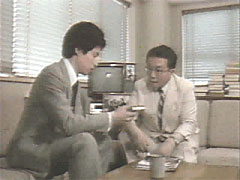1. Uchi / Soto: Keys to “Reading” Japanese Communication
Tatemae / honne are closely linked to another set of distinctions which are central in Japanese society: uchi / soto (inside/outside). Understanding how these distinctions work will allow you to “read” a variety of communication forms in Japan. The four video clips in this segment, reproduced with permission of Eleanor Harz Jorden and Mari Noda, offer you a good start in learning this.
Clue #1:
Body language: How do people enter the room in each of the clips above? Do they bow? How does interacting with someone who is soto versus uchi affect body language?
Clue #2:
Spoken language: How does the language used in these clips signal the uchi or soto relationships of the participants? For those who haven’t studied Japanese: Do the length of utterances indicate uchi / soto relationships? How about tone of voice?
Clue #3:
Tatemae / Honne: How much emotion (surprise, annoyance, frustration, etc.) are the participants showing in each of the clips? How much “inner” (or behind-the-scenes) honne content is being revealed? At which point(s) is tatemae being exhibited?
In each of these clips the uchi / soto relationships of the participants are signaled throughout. This occurs in virtually every word spoken, and in all the non-verbal communications, including body language and expression of tatemae / honne. Japanese are adept at “reading” these forms and understanding their relationship messages. You too need to become attuned to these messages; they have important consequences.
2.Uchi / Soto Relationships: Keys to Communicating
Clip 3 shows Deborah Miller, who is making her first visit to the Yamamori Research Institute (and is therefore in a soto relationship to the institute.) Clip 4 shows Kato and Brown, who are uchi members of the same university research group. Now take a look at Clips 3 and 4, keeping in mind the three clues listed above.
Putting things together. . . BASICS for communicating appropriately in Japan
The kinds of distinctions shown in the four classic clips above are made in all Japanese communications. For those learning Japanese, it’s not enough to learn vocabulary and grammar. There is more than one way to say EVERYTHING in Japanese, even the grunts one makes in conversational responses. These are all square one BASICS—native speakers can’t explain them, let alone fathom how you could possibly not know them. Below are a few of the basics:
- A crucial distinction occurs constantly in the spoken language: whether communication is taking place within uchi (in-group members), or between uchi / soto (insiders and outsiders). The same distinctions are also made constantly in virtually every form of non-verbal communication.
- Uchi / soto are more than simple either/or distinctions. The degree of inside/outsidedness is also spelled out when one makes an uchi / soto distinction. Thus uchi / soto defines an axis of distance (or closeness) along which relationships are gauged in each communication situation.
- The clips above show that formal/informal distinctions in spoken and body language are organized in ways that exactly parallel the uchi / soto distinctions described in 1 and 2 above. One communicates by “matching” one’s uchi / soto relationship distance with the appropriate degree of formality/informality in spoken language and body language; and the appropriate degree of tatemae versus honne in disclosure (or masking) of one’s self or in-group.
- You need to PAY CLOSE ATTENTION to the relationship distinctions that are being communicated to and around you, even if you can’t perform these initially. Messages about relationships (meaning the three points elaborated above) are actually more important than content messages in Japan, because the content message varies according to relationships. This means that relationship messages are the messages you need to look for.
If you overlook these relationship messages, it’s easy to misinterpret what’s going on, as Peter does below. In the next three sections we will explore how the same BASICS work in a communication form that is often overlooked—the design and use of space in family houses.



















